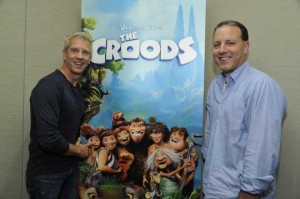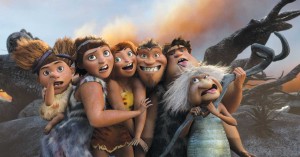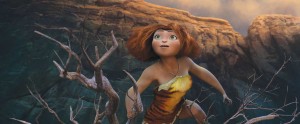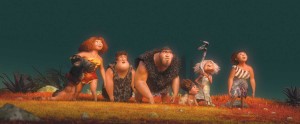
Some films are set in the past, and spend an enormous amount of time and effort in an attempt to recreate a bygone era as accurately as possible. The Croods takes great joy in not being one of those films.
Gleefully painting cats green and putting, as they say, “tusks on everything,” directors Chris Sanders and Kirk DeMicco have created a world in which giant petunias attempt to eat people and swarms of carnivorous parakeets move like clouds of dust in the wind, skeletonizing hapless creatures as they pass. The visual imagination of this hyper-realized prehistory is immense, and Sanders’ background in storyboard art , which he describes as “a mixture of things from the old days” of pen-and-ink character animation, is clear; his drawings of the principal characters are very directly realized on screen.
The film is a story of a prehistoric family and the life-changing experiences they encounter while fleeing tectonic upheaval in the company of that rarest of things: a stone-age inventor. The film emerged from the split of Dreamworks and Aardman Animation, who had teamed up for Chicken Run and subsequent projects. DeMicco had worked with John Cleese for a year on an adaptation of the Roald Dahl novel The Twits, and on a project then titled Crood Awakening, although he and Sanders agree that the final draft was a joint effort. “We write everything together,” DeMicco said. “We both know the material closely; we trust each other.” As such, the collaboration was very direct, with no particular tasks reserved to either director – with the possible exception of those vibrant concept drawings and storyboards, which are Sanders’ specialty.

His best known work is perhaps the Disney feature Lilo and Stitch, which he co-wrote and co-directed with Dean DeBlois (and voiced Stitch), alongside credits for art and design on Beauty and the Beast, The Lion King, Mulan, and others. The enormously successful How to Train Your Dragon, also from Dreamworks, won 10 Annies and was nominated for best animated feature and best original score at the 83rd Academy Awards.
So The Croods benefits hugely from the experience of the directors, but also from a cast including Nicolas Cage, Ryan Renolds, Cathering Keener, Clark Duke and Cloris Leachman. Behind-the-scenes footage shows Sanders and DeMicco directing side-by-side in the recording studio. Perhaps the greatest workshare, though, went to Emma Stone, voicing lead character Eep, designed on the basis that the directors did not want a princess, “She’s not an expected female lead,” DeMicco said. “We wanted her to be caveman pretty; someone who actually could survive.” The character design represents a carefully-considered degree of what might be called cavemanism, with Eep built like a swimmer, broad-shouldered but still someone you can enjoy watching for ninety minutes.
 Animation cues for the characters were taken from animals, with hulking father figure Grug based on the movements of a gorilla, a near-feral baby (the first animated test done by James Baxter, head of character animation) based on dogs, and Eep herself moving like a cat, echoing her tiger-striped outfit. While The Croods was entirely hand-animated by a staff of 400, DeMicco and Sanders were equally enthusiastic about motion capture as a planning tool. After Avatar, the ability to track and record the motion of both performers and a camera has become more readily available, providing the opportunity for cast and crew to get together in a manner more reminiscent of conventional filmmaking, which is rare in animation. DeMicco describes The Croods as an ensemble comedy where this new technique was particularly valuable as a directorial tool, even though none of the captured data is in the final product.
Animation cues for the characters were taken from animals, with hulking father figure Grug based on the movements of a gorilla, a near-feral baby (the first animated test done by James Baxter, head of character animation) based on dogs, and Eep herself moving like a cat, echoing her tiger-striped outfit. While The Croods was entirely hand-animated by a staff of 400, DeMicco and Sanders were equally enthusiastic about motion capture as a planning tool. After Avatar, the ability to track and record the motion of both performers and a camera has become more readily available, providing the opportunity for cast and crew to get together in a manner more reminiscent of conventional filmmaking, which is rare in animation. DeMicco describes The Croods as an ensemble comedy where this new technique was particularly valuable as a directorial tool, even though none of the captured data is in the final product.
 Other technical advances, particularly during and since Sanders’ previous How to Train Your Dragon, include fur and water. Given the period setting it is no surprise that The Croods is a tour de force for the relatively youthful art of hair simulation, with Eep’s expressive mop often large in frame. Despite its prehistoric setting, the level of technology involved is impressive. At the time, Dreamworks had over 3000 HP BladeSystem servers in its renderfarm, ably distributing the load of rendering a total of 80 million compute hours, more than any other film in its history. Still, with the absolute freedom of computer generation comes responsibility. According to Sanders, “we can do anything, but we can’t do everything.” Decisions about environments or entire suites of technology that are made early on are difficult to reverse later, although reanimating a character is easier: more or less a complete reversal of the situation under traditional animation.
Other technical advances, particularly during and since Sanders’ previous How to Train Your Dragon, include fur and water. Given the period setting it is no surprise that The Croods is a tour de force for the relatively youthful art of hair simulation, with Eep’s expressive mop often large in frame. Despite its prehistoric setting, the level of technology involved is impressive. At the time, Dreamworks had over 3000 HP BladeSystem servers in its renderfarm, ably distributing the load of rendering a total of 80 million compute hours, more than any other film in its history. Still, with the absolute freedom of computer generation comes responsibility. According to Sanders, “we can do anything, but we can’t do everything.” Decisions about environments or entire suites of technology that are made early on are difficult to reverse later, although reanimating a character is easier: more or less a complete reversal of the situation under traditional animation.
All this imagination comes at the cost of a huge amount of personal involvement, with both directors involved with the production for more than four years. And there’s more to come: a sequel is already in the works, with both directors attached, and a TV series is being spun up as I write. DeMicco tells us that it’s crucial to “always have something outside of work to keep you fresh,” which is understandable in a situation where the comedy must stay spontaneous and funny over such an extended production period.
So, there is more work yet to do. We should wish the directors of The Croods the will to survive another few years on the job, since when asked how they survived the multi-year production process of this notoriously labor-intensive artform, DeMicco responded with one tongue-in-cheek word, “Therapy.”
The result, though, is anything but crazy.





